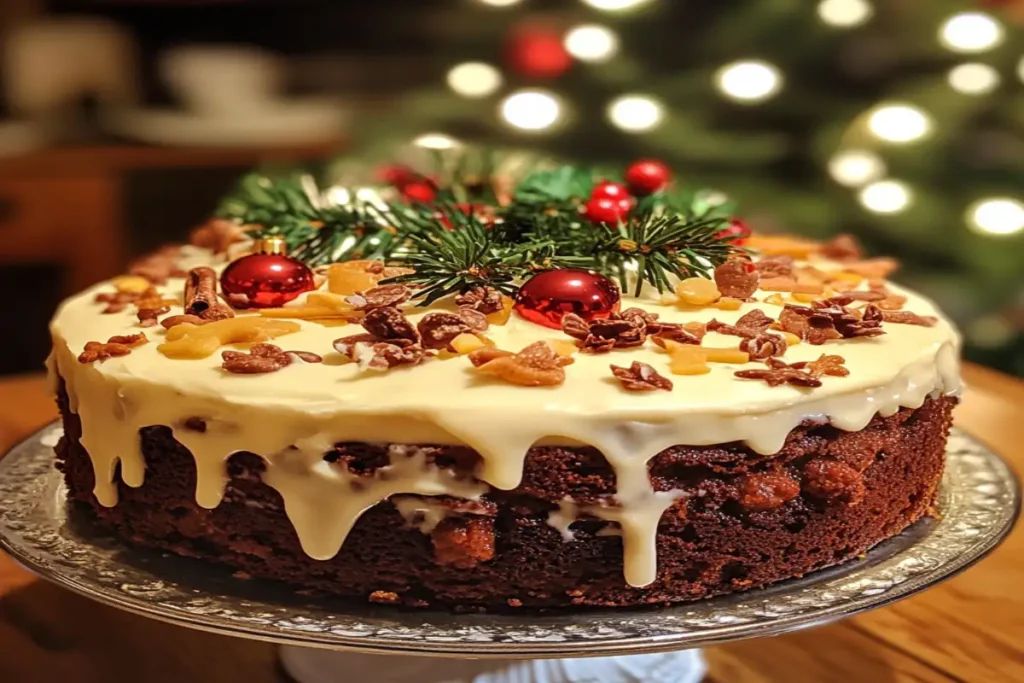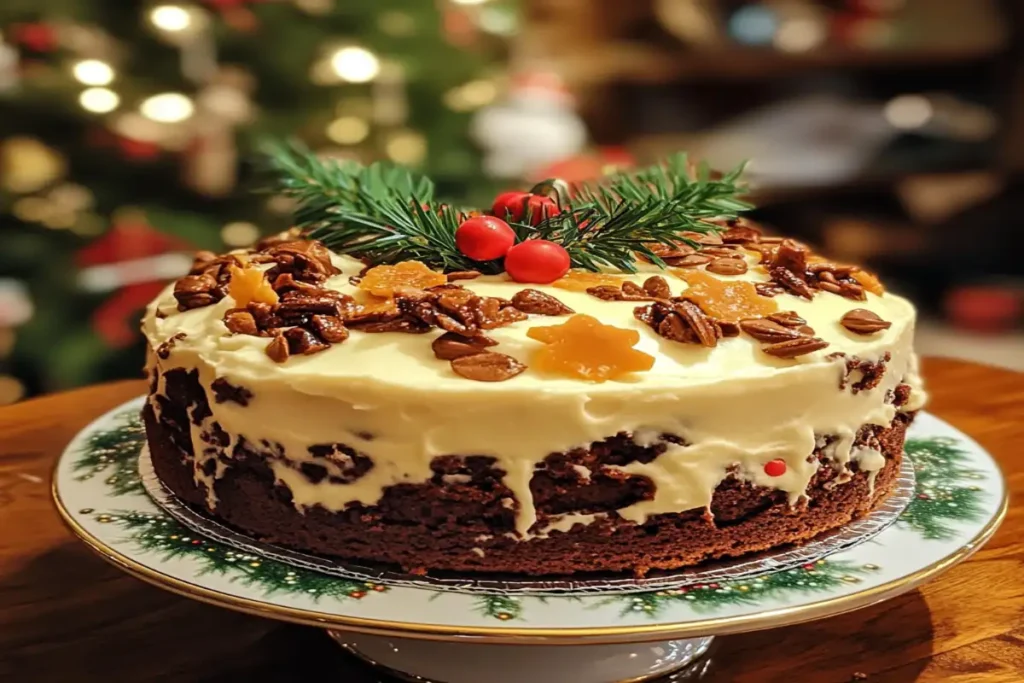Introduction: The Tradition of Christmas Cakes
The festive season is incomplete without the iconic Christmas cake. What type of cake is traditionally eaten at Christmas time? This cherished dessert holds a special place in holiday celebrations, symbolizing warmth, togetherness, and indulgence. Originating in Europe during medieval times, the Christmas cake started as a simple plum porridge, gradually transforming into the decadent and flavorful cake we know today. Rich with dried fruits, nuts, and warm spices, it reflects the festive spirit with every bite. Different regions have their unique versions, from the British fruitcake to Italy’s panettone and Germany’s stollen. Moreover, its intricate decorations and thoughtful preparation make it a centerpiece of holiday feasts. Whether baked weeks in advance to enhance its flavor or enjoyed fresh, the Christmas cake continues to bring joy to families worldwide, creating sweet memories during the most wonderful time of the year.
Popular Types of Christmas Cakes Around the World

Different countries celebrate the festive season with unique variations of the Christmas cake. So, what type of cake is traditionally eaten at Christmas time across the globe?
- United Kingdom: The classic fruitcake, often soaked in brandy or rum, serves as a staple.
- Italy: Panettone, a light, fluffy cake filled with dried fruits, delights families during Christmas.
- Germany: Stollen, a dense loaf-shaped cake, combines fruits, nuts, and a dusting of powdered sugar.
- France: Bûche de Noël, or Yule log, features a rolled sponge cake filled with cream and decorated to resemble a log.
Each variation reflects cultural preferences while adhering to the essence of a Christmas cake: indulgence and festivity. These cakes not only satisfy sweet cravings but also unite families during the holidays.
Ingredients Needed for a Classic Christmas Cake
To create a traditional Christmas cake, high-quality ingredients are essential. But what type of cake is traditionally eaten at Christmas time? A rich fruitcake demands the following staples:
- Dried fruits: Raisins, currants, and sultanas form the core.
- Spices: Cinnamon, nutmeg, and cloves enhance the flavor.
- Liquor: Brandy or rum deepens the taste and preserves the cake.
- Nuts: Almonds and walnuts provide texture.
- Citrus zest: Orange and lemon zest balance the sweetness.
- Butter and sugar: For richness and moisture.
- Flour and eggs: The foundation of the cake.
These ingredients work in harmony, creating a dessert that’s both flavorful and satisfying. Preparing them carefully ensures the cake’s signature taste and texture.
Step-by-Step Guide to Making a Traditional Christmas Cake
Crafting a Christmas cake is a rewarding process. Wondering what type of cake is traditionally eaten at Christmas time and how to make it? Follow these steps:
- Prepare the dried fruits: Chop and soak them in liquor a day before baking to infuse flavor.
- Mix the dry ingredients: Combine flour, spices, and nuts in a bowl.
- Cream butter and sugar: Whip these ingredients until light and fluffy.
- Add eggs: Incorporate one at a time for a smooth batter.
- Fold in fruit and dry mixture: Gently combine to avoid overmixing.
- Transfer to a pan: Line the pan with parchment paper for even baking.
- Bake: Use a low temperature to ensure slow and steady cooking.
Patience is key. Allow the cake to cool before adding decorations or storing it for future enjoyment.
How to Soak Dried Fruits for Christmas Cake
A hallmark of traditional Christmas cake is its luscious fruit filling. What type of cake is traditionally eaten at Christmas time that requires soaked fruits? A fruitcake, of course! To soak dried fruits:
- Choose the fruits: Include raisins, cherries, apricots, and cranberries.
- Select the liquor: Brandy or rum is traditional, but orange juice works for non-alcoholic versions.
- Combine and mix: Place fruits in a bowl, add liquor, and stir to coat evenly.
- Cover and store: Seal tightly and let sit for at least 24 hours, stirring occasionally.
This process enhances the fruit’s flavor and ensures a moist cake. Properly soaking fruits elevates the cake’s overall quality and makes it irresistible.
Tips for Baking the Perfect Christmas Cake
Baking a flawless Christmas cake requires attention to detail. So, what type of cake is traditionally eaten at Christmas time that benefits from these tips?
- Start early: Bake weeks in advance to allow the flavors to mature fully. Consequently, this step ensures the cake develops its characteristic depth.
- Line the pan: Use parchment paper to prevent sticking and ensure even cooking. Additionally, this helps with an easier cleanup process.
- Slow bake: Low temperatures ensure even cooking without burning. As a result, the cake maintains its moisture and avoids overbaking.
- Test for doneness: Insert a skewer; it should come out clean. Otherwise, return it to the oven for a few more minutes to avoid undercooking.
- Feed the cake: Brush it with liquor weekly to maintain moisture and enhance flavor. Moreover, this step adds richness and longevity to the cake.
These techniques, when followed carefully, guarantee a moist, flavorful cake that embodies the festive spirit and delights everyone at the table.

Spices That Define the Flavor of a Christmas Cake
TThe aromatic spices used in Christmas cake are its defining feature. So, what type of cake is traditionally eaten at Christmas time that’s synonymous with warm spices? A fruitcake enriched with:
- Cinnamon: Adds warmth and sweetness. Furthermore, it enhances the overall flavor profile of the cake.
- Nutmeg: Provides a subtle, earthy flavor. Additionally, it complements the other spices perfectly.
- Cloves: Delivers a bold, spicy kick. As a result, it creates a distinct and festive aroma.
- Ginger: Introduces a hint of zestiness. Moreover, it balances the sweetness of the dried fruits.
These spices, when combined thoughtfully, create a symphony of flavors, evoking the cozy ambiance of Christmas. Consequently, incorporating them in the right proportions ensures a balanced and delectable cake that everyone will enjoy.
Best Alcohol Choices for Christmas Cake Recipes
Selecting the right alcohol is crucial for enhancing a Christmas cake’s flavor. But what type of cake is traditionally eaten at Christmas time that benefits from liquor? The classic fruitcake. Recommended options include:
- Brandy: A traditional favorite for its rich flavor.
- Rum: Adds depth and sweetness to the cake.
- Whiskey: Offers a robust, smoky undertone.
- Port: Enhances the fruity notes naturally present in the cake.
For non-alcoholic cakes, fruit juices like orange or apple can be used. These substitutes complement the cake’s natural flavors while ensuring a moist texture.
Non-Alcoholic Options for a Family-Friendly Christmas Cake
Creating a non-alcoholic version of a Christmas cake ensures everyone in the family can enjoy it. What type of cake is traditionally eaten at Christmas time without alcohol? A fruitcake made with flavorful alternatives like:
- Fruit juices: Orange, apple, or grape juice infuses the cake with natural sweetness.
- Tea infusions: Strongly brewed black tea adds a rich, earthy undertone.
- Maple syrup or honey: Provides moisture and subtle sweetness to the cake.
By substituting alcohol with these options, you retain the moist texture and robust flavor of a traditional Christmas cake, making it suitable for all ages.
Creative Decoration Ideas for Christmas Cakes
A beautifully decorated Christmas cake is the centerpiece of any holiday table. What type of cake is traditionally eaten at Christmas time that shines with festive decor? Here are some ideas:
- Icing layers: Use marzipan and fondant to create a smooth finish.
- Festive toppers: Add miniature trees, Santa figures, or snowflakes for charm.
- Edible glitter: Sprinkle a touch of shimmer for a magical effect.
- Fresh fruits and nuts: Arrange cranberries and almonds for a natural look.
Decorations enhance the cake’s visual appeal and make it a true festive delight.
How to Store Your Christmas Cake for Maximum Freshness
Proper storage ensures your Christmas cake remains fresh and flavorful. What type of cake is traditionally eaten at Christmas time that requires careful preservation? A fruitcake benefits from:
- Wrapping tightly: Use parchment paper and foil to lock in moisture.
- Airtight containers: Prevent exposure to air.
- Cool, dark places: Avoid sunlight and heat to prevent drying.
- Feeding regularly: Brush with liquor or juice to maintain moisture.
These steps ensure your cake stays delicious for weeks, allowing you to savor it throughout the holiday season.
Pairing Your Christmas Cake with Drinks and Desserts
Pairing enhances the enjoyment of a Christmas cake. What type of cake is traditionally eaten at Christmas time that pairs well with:
- Drinks: Mulled wine, spiced cider, or black tea complement the flavors.
- Desserts: Ice cream, whipped cream, or custard balance the richness of the cake.
These combinations elevate the festive experience, complementing the cake’s rich flavors.
FAQs: Common Questions About Christmas Cakes
Curious about what type of cake is traditionally eaten at Christmas time? Here are some frequently asked questions:
- Can I make a Christmas cake without alcohol? Yes, use fruit juice or tea as a substitute.
- How long does a Christmas cake last? It lasts up to three months if stored properly.
- Do I need to soak fruits? It’s highly recommended for better flavor and texture.
- Can I freeze a Christmas cake? Yes, wrap it tightly in plastic wrap and foil before freezing.
- What is the best time to start baking a Christmas cake? Ideally, start baking it a few weeks before Christmas to allow the flavors to mature.
- How can I make my Christmas cake moist? Regularly brush it with liquor or fruit juice during storage.
- What toppings work best for decorating a Christmas cake? Traditional options include marzipan, royal icing, and dried fruits.
- Can I bake a Christmas cake in smaller portions? Yes, divide the batter into smaller pans and adjust the baking time accordingly.
- Why does my Christmas cake crack on top? Cracks usually occur due to high oven temperatures or overmixing the batter.
- Is it necessary to feed a Christmas cake with liquor? No, but feeding enhances the flavor and extends its shelf life.
Conclusion: Celebrating the Festive Season with Cake
The Christmas cake remains a timeless symbol of holiday cheer and unity. What type of cake is traditionally eaten at Christmas time? The answer varies across cultures, yet the shared sentiment behind this festive dessert is universal. Whether it’s the classic British fruitcake, Italian panettone, or German stollen, each version captures the essence of the season—joy, warmth, and celebration. From selecting the finest ingredients to adding creative decorations, baking a Christmas cake is more than just a culinary task; it’s a cherished tradition that brings families together. Moreover, pairing it with the right drinks and desserts enhances the holiday experience, making every bite memorable. By preserving this tradition and exploring modern twists, we keep the spirit of Christmas alive. Ultimately, the Christmas cake isn’t just a dessert; it’s a heartfelt way to create lasting memories during the most wonderful time of the year.

